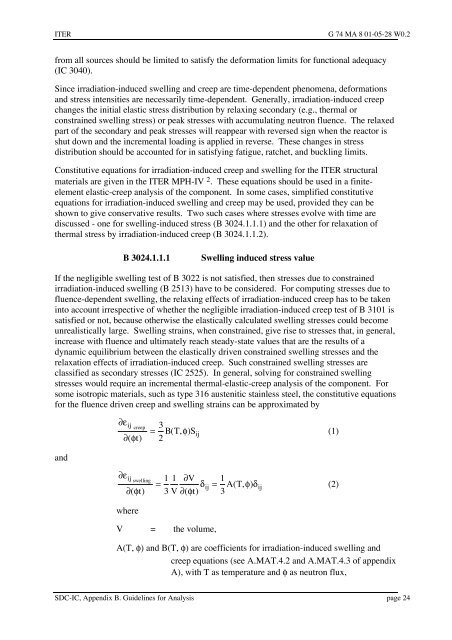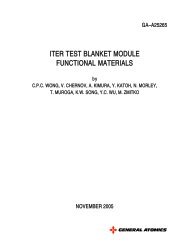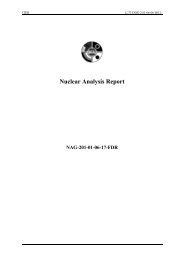iter structural design criteria for in-vessel components (sdc-ic)
iter structural design criteria for in-vessel components (sdc-ic)
iter structural design criteria for in-vessel components (sdc-ic)
You also want an ePaper? Increase the reach of your titles
YUMPU automatically turns print PDFs into web optimized ePapers that Google loves.
ITER G 74 MA 8 01-05-28 W0.2<br />
from all sources should be limited to satisfy the de<strong>for</strong>mation limits <strong>for</strong> functional adequacy<br />
(IC 3040).<br />
S<strong>in</strong>ce irradiation-<strong>in</strong>duced swell<strong>in</strong>g and creep are time-dependent phenomena, de<strong>for</strong>mations<br />
and stress <strong>in</strong>tensities are necessarily time-dependent. Generally, irradiation-<strong>in</strong>duced creep<br />
changes the <strong>in</strong>itial elast<strong>ic</strong> stress distribution by relax<strong>in</strong>g secondary (e.g., thermal or<br />
constra<strong>in</strong>ed swell<strong>in</strong>g stress) or peak stresses with accumulat<strong>in</strong>g neutron fluence. The relaxed<br />
part of the secondary and peak stresses will reappear with reversed sign when the reactor is<br />
shut down and the <strong>in</strong>cremental load<strong>in</strong>g is applied <strong>in</strong> reverse. These changes <strong>in</strong> stress<br />
distribution should be accounted <strong>for</strong> <strong>in</strong> satisfy<strong>in</strong>g fatigue, ratchet, and buckl<strong>in</strong>g limits.<br />
Constitutive equations <strong>for</strong> irradiation-<strong>in</strong>duced creep and swell<strong>in</strong>g <strong>for</strong> the ITER <strong>structural</strong><br />
materials are given <strong>in</strong> the ITER MPH-IV 2 . These equations should be used <strong>in</strong> a f<strong>in</strong>iteelement<br />
elast<strong>ic</strong>-creep analysis of the component. In some cases, simplified constitutive<br />
equations <strong>for</strong> irradiation-<strong>in</strong>duced swell<strong>in</strong>g and creep may be used, provided they can be<br />
shown to give conservative results. Two such cases where stresses evolve with time are<br />
discussed - one <strong>for</strong> swell<strong>in</strong>g-<strong>in</strong>duced stress (B 3024.1.1.1) and the other <strong>for</strong> relaxation of<br />
thermal stress by irradiation-<strong>in</strong>duced creep (B 3024.1.1.2).<br />
B 3024.1.1.1 Swell<strong>in</strong>g <strong>in</strong>duced stress value<br />
If the negligible swell<strong>in</strong>g test of B 3022 is not satisfied, then stresses due to constra<strong>in</strong>ed<br />
irradiation-<strong>in</strong>duced swell<strong>in</strong>g (B 2513) have to be considered. For comput<strong>in</strong>g stresses due to<br />
fluence-dependent swell<strong>in</strong>g, the relax<strong>in</strong>g effects of irradiation-<strong>in</strong>duced creep has to be taken<br />
<strong>in</strong>to account irrespective of whether the negligible irradiation-<strong>in</strong>duced creep test of B 3101 is<br />
satisfied or not, because otherwise the elast<strong>ic</strong>ally calculated swell<strong>in</strong>g stresses could become<br />
unrealist<strong>ic</strong>ally large. Swell<strong>in</strong>g stra<strong>in</strong>s, when constra<strong>in</strong>ed, give rise to stresses that, <strong>in</strong> general,<br />
<strong>in</strong>crease with fluence and ultimately reach steady-state values that are the results of a<br />
dynam<strong>ic</strong> equilibrium between the elast<strong>ic</strong>ally driven constra<strong>in</strong>ed swell<strong>in</strong>g stresses and the<br />
relaxation effects of irradiation-<strong>in</strong>duced creep. Such constra<strong>in</strong>ed swell<strong>in</strong>g stresses are<br />
classified as secondary stresses (ICÊ2525). In general, solv<strong>in</strong>g <strong>for</strong> constra<strong>in</strong>ed swell<strong>in</strong>g<br />
stresses would require an <strong>in</strong>cremental thermal-elast<strong>ic</strong>-creep analysis of the component. For<br />
some isotrop<strong>ic</strong> materials, such as type 316 austenit<strong>ic</strong> sta<strong>in</strong>less steel, the constitutive equations<br />
<strong>for</strong> the fluence driven creep and swell<strong>in</strong>g stra<strong>in</strong>s can be approximated by<br />
and<br />
e<br />
ij creep<br />
( ft)<br />
= BT ( , f)<br />
S<br />
3<br />
2<br />
eij<br />
swell<strong>in</strong>g 1 1 V 1<br />
= d = AT ( , f) d<br />
( ft)<br />
3 V ( ft) 3<br />
where<br />
V = the volume,<br />
ij<br />
ij ij<br />
A(T, f) and B(T, f) are coeff<strong>ic</strong>ients <strong>for</strong> irradiation-<strong>in</strong>duced swell<strong>in</strong>g and<br />
creep equations (see A.MAT.4.2 and A.MAT.4.3 of appendix<br />
A), with T as temperature and f as neutron flux,<br />
SDC-IC, Appendix B. Guidel<strong>in</strong>es <strong>for</strong> Analysis page 24<br />
(1)<br />
(2)




